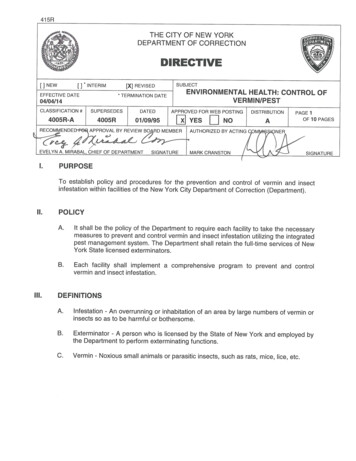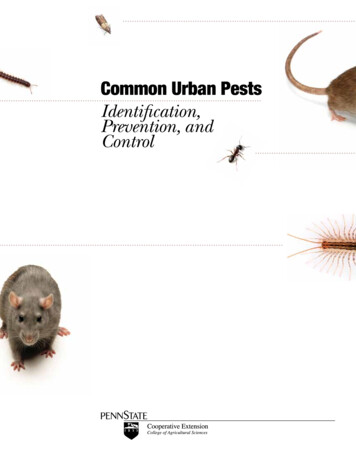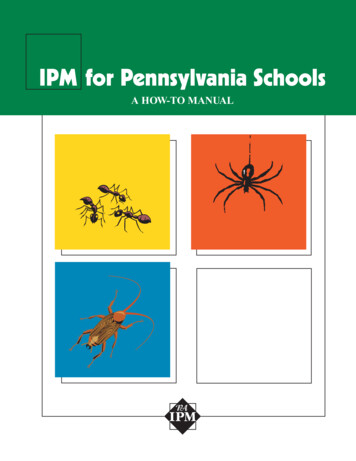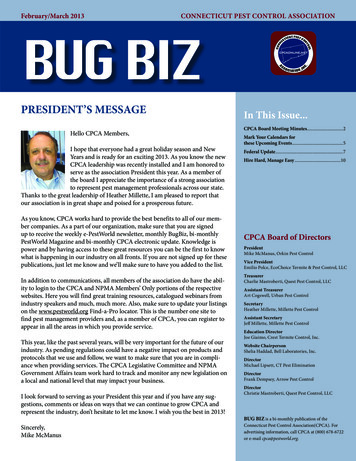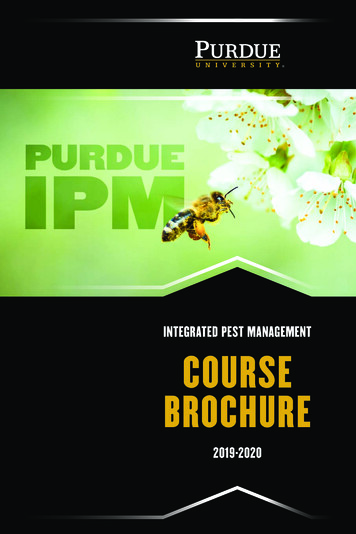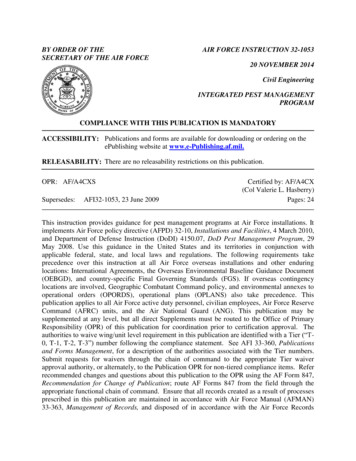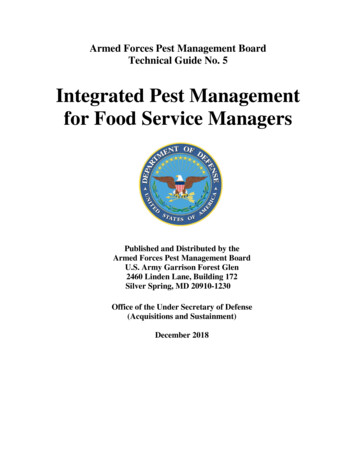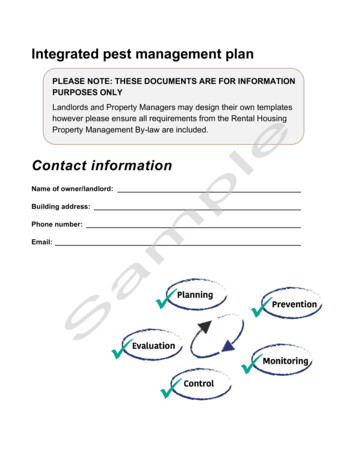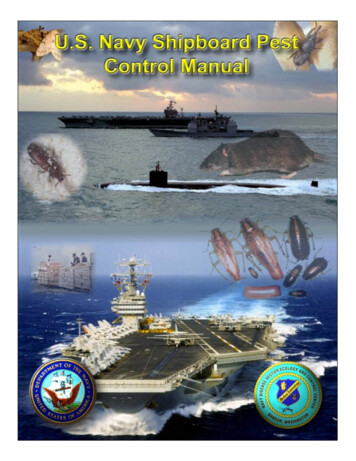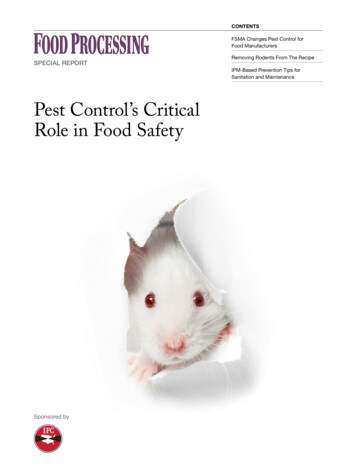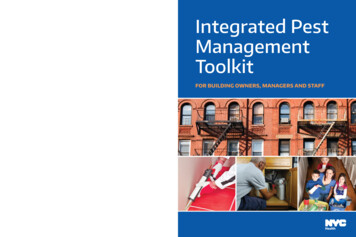
Transcription
Integrated PestManagementToolkitFOR BUILDING OWNERS, MANAGERS AND STAFF
Integrated PestManagementToolkitFOR BUILDING OWNERS, MANAGERS AND STAFFPests, including cockroaches, rats and mice, are common in NewYork City (NYC), especially in high-poverty neighborhoods with poorlymaintained buildings. In some neighborhoods, more than 50% ofhouseholds report seeing cockroaches on a daily basis and mice withinthe last three months.* Pests, especially cockroaches and mice, affectindoor air quality and can trigger allergic reactions or asthma attacks insome people. Asthma affects more than one million New Yorkers.*Integrated Pest Management (IPM) is a prevention-based pestmanagement method that provides long-lasting pest control, improvesbuilding conditions and is less harmful to residents and pets thantraditional pest control.Whereas traditional pest control relies on regularly scheduled pesticideapplications, IPM targets the underlying causes of pest infestationsthrough simple pest proofing strategies such as fixing leaks and holesand managing garbage to deprive pests of food, water, shelter andways to get around. If pesticides must be used, IPM uses the least toxicchemicals, applied in the safest manner to protect people and pets.Using IPM in your building can provide long-term effective pest control,prevent pest-related damage to buildings, improve building and airquality and reduce resident complaints. It is also consistent with goodbuilding management and can save time and money in the long run.This toolkit is designed to support building-wide implementation of IPM.For additional information or specific questions, please emailhealthyhomes@health.nyc.gov or call 311 and ask for “Healthy Homes.”*New York City Department of Health and Mental Hygiene. Community HealthSurvey 2014; public use dataset accessed on June 28, 2016.
Selecting and Working with aPest Management ProfessionalPest management professionals (also known asexterminators or pest control companies) can provideboth Integrated Pest Management (IPM) and traditionalpest services. Pest management professionals (PMPs)are licensed to apply pesticides by the New YorkState Department of Environmental Conservationand regularly participate in trainings on pest controlfor insects, mice and rats. In New York, only licensedprofessionals can apply pesticides in commercial andmulti-family buildings.When choosing a PMP, ask specifically for IPM servicesand look for experience providing IPM services inresidential buildings. Give the PMP a copy of theIntegrated Pest Management (IPM) Model Scope ofServices in this toolkit.Selecting a Pest ManagementProfessionalFind licensed PMPs through the New York StateDepartment of Environmental Conservation by visitingwww.dec.ny.gov. Compare services and pricing amongat least three different PMPs.Integrated Pest Management (IPM)is a prevention-based pest managementmethod that provides long-lasting pestcontrol, improves building conditions andis less harmful to residents and pets thantraditional pest control.Whereas traditional pest control relies onroutine pesticide applications, IPM targetsthe underlying causes of pest infestationsthrough simple pest proofing strategiessuch as fixing leaks and holes and managinggarbage to deprive pests of food, water,shelter and ways to get around.If pesticides must be used, IPM uses the leasttoxic chemicals, applied in the safest mannerto protect people and pets.For more information, visit nyc.gov/healthor call 311 and ask for “Healthy Homes.”WHO TO HIRELook for PMPs that:Hire the PMP that: Advertise IPM services and havelicensed professionals applyingpesticides. Has good references. Ask to talk tobuilding managers whose buildingshad similar problems. Have positive reviews onsocial media. Has enough staff to match buildingsize and needs, including emergencyresponse within 24 hours. Will inspect the entire property(interior and exterior) and providea written report before quoting afinal price. Offers the right service plan andpricing structure. The lowest bidmay not always be the best solution.
Working with a Pest Management ProfessionalInitial Inspection and ReportDuring the initial inspection, the PMP should look for evidence of pests and identifyproblem areas and building conditions or practices that support pests. The PMP shouldinspect the interior of the building, including apartments with reported pests, garbagestorage areas and other common areas, as well as the exterior areas of the building. ThePMP should provide a written report of the inspection findings and recommended pestcontrol actions. The PMP may charge a fee for this initial inspection.A building representative (property manager or building supervisor) should accompanythe PMP during all visits to provide access to service areas and give input on the statusof pest problems on site.Description of Estimate and ServicesThe PMP’s service estimate must contain a pest monitoring plan and a description of pestmanagement methods, including sanitation improvements and pest exclusion measures:1. Pest Monitoring PlanrThe pest monitoring plan should include: A service schedule that shows how often the PMP will come to the building andwhich building areas will be inspected during each visit. Additional areas can beadded as new problems are identified. The pest monitoring plan should providea description of the technician’s responsibilities during each regularly scheduledservice visit. During each visit, technicians should:V Meet with the building representative and review any recent pest complaintsV Identify the extent of any current infestationV Determine the control options most appropriate for the specific location and typeof pestV Identify and report conditions that attract pestsV If possible, treat affected area(s) using a non-chemical or reduced-risk method ormake arrangements to schedule treatmentV Check bait boxes and trapsV Provide records of the services provided (see Recordkeeping) The method of monitoring for pests and a description of the monitoring devices tobe used, such as traps and glue boards. Some PMPs may provide a map showingwhere monitoring devices will be placed on the property. Insect monitors can beused for cockroaches and other insects; glue boards and rodent monitoring blockscan be used for mice and rats.
2. Services and Treatment DescriptionsThe PMP’s service estimate must also include a description of the pest managementmethods that will be used for each type of pest. The PMP should provide vacuuming,cleaning and steaming services to remove pests and nests, and use the least toxicmaterials, such as gel roach bait, rodent traps, etc. High Efficiency Particulate Air(HEPA) vacuums and steam cleaners are recommended to remove existing insectsand reduce grease and food sources. Chemical control methods such as containerizedbaits, gel baits and reduced risk pesticides should be used judiciously. PMPs shouldnever use fogs or bombs and should limit the use of sprays to areas inaccessible topeople and pets.Sealing should be the first line of defense. Some PMPs may provide sealing services forsmall gaps and holes. Larger holes and related repairs are typically the responsibility ofbuilding staff. The scope of services should clearly describe the responsibilities of thePMP and of building management.The PMP should provide written treatment plans for each type of pest. Some pestsrequire treatment plans with additional considerations. For example: Mice and Rats: The PMP should check for rats and mice found inside and outsidebuildings. The PMP is responsible for pick-up and proper disposal of dead rodentsunless other arrangements are made. This should be included in the scope of services. Bed Bugs: Bed bug services may be billed separately from the regular pestmanagement contract. Services for bed bugs should adhere to the NationalPest Management Association’s “Best Management Practices for Bed Bugs” (seebedbugbmps.org). Apartments next to and across from infested apartments shouldalso be checked for evidence of bed bugs and, if necessary, treated with reduced riskchemicals. PMPs should conduct at least two follow-up visits in infested apartments. Unit Turnover Services: The scope of services should specify who (buildingmanagement or PMP) is responsible for conducting turnover pest inspections whena resident vacates a unit. The purpose of this inspection is to document pest activityand building conditions that may attract pests. PMPs should provide treatment asnecessary when apartments are prepared for occupancy and install preventativemeasures as appropriate. Turnover preparation may also include structural repairsto correct building issues that may attract pests. A unit should only be treated withchemicals at turnover if there is evidence of a pest infestation.3. RecordkeepingPMPs must keep and provide records detailing the following: Specific pesticides used during each service and pest(s) treated Specific work done in a unit Future treatment required Conditions that may attract pests Pest complaint tracking
4. EvaluationrEstimates should include a description of the PMP’s quality assurance plan, a keycomponent of which is a full site inspection at least once a year. Services should beadjusted as needed based on information gained during visits.PMPs should provide indicators for demonstrating improvement over time, such asreduced pest activity, fewer pest complaints, fewer pest control materials used andreduced service time.BUILDING MANAGER RESPONSIBILITIES Accompany the PMP at every visit and track measures to remove andprevent pests. Implement and follow up on building maintenance recommendations. Respond to resident complaints in a timely manner. Log pest issues and inform PMP at every visit. Require a written report from PMP after every visit. Manage garbage and keep garbage storage areas and compactors clean(see Building Garbage Control and Compactor Maintenance).When reviewing the scope of services, keep inmind the following: Routine pesticide application is not a part of IPM. Use of aerosol spray is limited tocracks and crevices treatments. Baseboard and broadcast spray applications arenever used. PMPs must get building manager approval for all pesticide use. All pesticides musthave a manufacturer’s label and be used according to label instructions. Never useunlabeled or illegal pesticides. For more information, see Pesticide Safety. Rodenticides should be used only when attempts at exclusion, sanitation and trappingare unsuccessful. Only use rodenticides in tamper-resistant bait stations or placeddeep into rat burrows. Label bait stations with the date placed, product name and PMPcontact information. Tracking powder should never be used in areas where people oranimals can be exposed; the powder can contaminate human food and water. PMPs should outline a communication plan for reporting pest activity, buildingconditions or problems in need of maintenance that are outside the scope of pestcontrol services.
Integrated PestManagement (IPM)Model Scope of Services
When negotiating a building-wide pest control service agreement with a pest management professional (PMP),give this model Integrated Pest Management (IPM) scope of services to the vendor for reference. The model is auseful template for developing a customized scope of services that includes required services for any property.Pest Management Professional:Building Management:Property Name and Address:Period of Service:(date) to(date)Scope of Services:Initial IPM Inspection:PMP will conduct initial interior and exterior inspection and provide a written report that identifies problem areas andrecommends structural, sanitary and/or procedural modifications to reduce pests’ access to food, water and shelter.IPM Monitoring Plan:PMP will submit a monitoring plan for building manager approval in advance of any contracted work.The plan will include:1. An ongoing monitoring proposal for all locations where there is an active infestation, pest evidence or conditionspotentially leading to infestation2. Meetings or calls after treatment of infested areas3. Recommended procedures for unit turnoverVisits will occur (ex: monthly, weekly, etc.).The PMP will inspect the following areas during each service visit:(ex: unit #, exterior, basement, etc.)IPM Services:Treatment services will include: Sealing openings, cracks, crevices, entry points andother locations with pests/pest debris or where foodand/or water can collect Applying approved gel, baits and pesticides asspecified in the Pesticide Use section below, and onlyas needed Removing pests, debris, food and dust with HighEfficiency Particulate Air (HEPA) vacuuming andsteam cleaners Placing sticky traps and other monitoring devices inappropriate locations and monitoring pest activities P MP will use wet cleaning methods when removingrodent nests and nesting materials to preventspreading allergens and pest waste during removal Communicating findings to building manager ordesignated agent as outlined in Recordkeeping section
Service Descriptions:1. Emphasis on Non-Pesticide Methodsi. Standard use of non-pesticide methods as first andprimary means of pest controlii. Standard use of portable HEPA vacuums rather thanpesticide sprays for initial cleanouts of cockroachinfestationsiii. Standard use of trapping devices rather thanpesticide sprays for indoor fly control2. Insect Controli. Application of Insecticides to Cracks and Crevices:Insecticides will be applied ONLY in “crack andcrevice” treatments. Formulated insecticide willnot be visible to a bystander during or after theapplication process.a. A ll labor and materials will be furnished to providecontrol of roaches, ants, silverfish and rodents.b. A ll harborage areas (i.e., cabinets, sinks, closets,pantries) and cracks, crevices and breeding siteswhere pests have been identified will be treatedwith roach bait gels.c. Roach bait gels will be odorless, non-volatile andwill not produce airborne particles. They will bedesigned for use in sensitive areas and residentswill not need to remove edibles or dishes fromcabinets or vacate premises during application.d. During each service visit, special attention will bepaid to kitchen and bath areas, including spacesbeneath sinks, counters, appliances, etc.ii. Application of Sprays or Insecticides to ExposedSurfaces: Fogging is prohibited and the applicationof spray insecticides to exposed surfaces will belimited. If use is required, PMP will obtain approvalfrom the building manager prior to any applicationof insecticide to an exposed surface or applicationof a spray treatment. PMP will ensure resident andemployee safety and employ necessary precautionsfor the containment of the pesticide to the siteof application. No surface application or spacespraying will be conducted while resident(s) orpersonnel are present.iii. Insecticide Bait Formulations: Bait formulations will bethe standard pesticide technology for cockroach andant control, with alternate formulations restricted tounique situations where baits are not practical.iv. Monitoring: Sticky traps will be used to guideand evaluate indoor insect control efforts wherenecessary.3. Rodent Controli. Trapping: PMP will use trapping as the first methodof indoor rodent control. Traps will be out of generalview and in protected areas so as not to be affectedby routine cleaning and other operations. PMP willcheck trapping devices on a schedule approvedby the building manager. All trapped rodentsand all rodent carcasses will be disposed of in anappropriate manner.ii. Use of Rodent Bait (rodenticides): When used inconjunction with other structural and mechanicalcontrols, rodent baits are an effective means ofproviding long-term control with a minimal riskto people, pets and wildlife. The PMP must obtainbuilding manager’s approval prior to starting anyinterior rodenticide treatment. When used indoors,baits will always be installed within tamper-resistantbait stations and in out-of-reach areas. All baitstations (inside and outside) will be maintainedin accordance with the Environmental ProtectionAgency’s (EPA) regulations, with an emphasis on thesafety of non-target organisms and in adherence tothe following:a. All bait stations must be placed out of generalview, in locations where they will not be disturbedby routine operations.b. The lids of all bait stations must be securelylocked or fastened shut.c. All bait stations must be securely attached oranchored to the floor, ground, wall or otherimmovable surface so that the box cannot bepicked up or moved.d. The bait must always be secured in the feedingchamber of the bait station and never placed inthe runway or entryways of the bait station.e. All bait stations must be labeled on the inside withthe PMP’s business name and address, and datedby the PMP at the time of installation and at eachfollow-up service.f. All bait stations should be numbered and theirlocation marked on a simple floor plan map. ThePMP should leave a copy of the map along with thepesticide’s label with the building manager.g. Bait stations should be inspected during everyservice visit for monitoring purposes and toensure stations are not providing harborage tonon-target pests. When using rodent bait outdoors, the PMP willplace loose bait-like pellets or meal deep insiderat burrows. When this is not feasible, the PMP willinstall bait stations along the paths that rats travel.All rodenticides, regardless of packaging, must beplaced either in locations not accessible to children,
pets or wildlife, or in EPA-approved tamper-resistantbait stations. When rodenticide is prohibited in anarea such as an organic garden, the PMP will usetrapping devices.4. Pesticide UseThe PMP will adhere to the following rules for pesticide use:i. Approved Products: Only apply pesticide productsthat have been included in the IPM Plan andapproved in writing by the building manager.ii. Prohibited Products: Do not use foggers or bombs,organophosphate or chlorinated hydrocarbonspesticides. Do not use broadcast or baseboard sprayapplications.iii. Pesticide Storage: Do not store any pesticideproducts in the buildings specified in the contract.iv. Application by Need: Apply pesticides accordingto need and not by schedule. Do not applypesticides in any inside or outside area unlessvisual inspection or monitoring devices indicatethe presence of pests in that specific area andactionable levels specified in IPM Plan areexceeded.v. Minimization of Risk: When pesticides are necessary,use only the least hazardous materials, with themost precise application technique, and with theminimum quantity of pesticide necessary to achievecontrol. Apply pesticides in a manner that is safeand inaccessible to residents and pets.vi. Notification: Provide a written notice of theintention to apply pesticides at least 24 hours inadvance. List rooms, apartments and other areas tobe sprayed with insecticides someplace visible, atleast 24 hours before application.vii. Emergency Procedures: In case of emergencysituations, request written approval if it isnecessary to vary from the above procedures.5. Recordkeepingi. Recordkeeping Forms: The PMP will submit to thebuilding manager a signed, dated checklist foreach building site visited that will include: record ofmonitoring device results, list of all actions taken,list of threshold information, location, brand nameand active ingredient for any preapproved pesticideproduct used, and list of problem apartments.ii. Service Updates to Building Management: PMPwill schedule monthly meetings with buildingmanager to provide an update on work performed,an assessment of existing problem areas and futuretreatment plans. The PMP will provide an annualsummary of pesticide uses, brand names and activeingredients, progress and planned activities forproblem infestation areas.iii. Proof of Service Guarantee: All invoices will beaccompanied by proper proof of service, includingthe date of service, the technician’s time of arrivaland departure and a detailed report of all servicesperformed, including target pests, method ofextermination, chemicals/products used andlocations of use. This proof of service is to beverified and signed by either the super or buildingmanager in the case of regular extermination orspecial common area treatments, or the residentin the case of bedbug and/or any other apartmentspecific treatment. Invoices will not be paid unlessPMP provides acceptable proof of service.ASK FOR PROOF OF QUALIFICATIONSr License from New York State Departmentof Environmental Conservationr IPM policy and proceduresNote: If building management also has an IPM policyfor the property, provide a copy to the PMP. It isthe responsibility of the PMP to make sure that theservices provided are consistent with professionalpolicy and building management policy.r References who can speak to PMP’s IPM service
Pest Management Opportunitiesduring Building RenovationsPest proofing during renovation saves time and future costs by reducing resident pest complaints, minimizing thedestruction caused by pests and increasing the quality and value of the renovations. It also makes the buildinghealthier for residents by reducing asthma triggers. During renovations, look for opportunities to fix leaks andmoisture problems, seal cracks and holes and use pest-resistant materials.Before RenovationHire a pest management professional (PMP) with experience in Integrated PestManagement (IPM) to inspect the building, review resident complaints and reportpest conditions and ways to eliminate them. Common IPM recommendations include:þ Putting cockroach bait (gels, traps) in apartments and common areasþ Applying boric acid behind walls to kill cockroaches and prevent new infestationþ Using rodent traps and/or baitsþ Sealing holes and cracksþ Fixing leaks and repairing water damaged areasTalk to the PMP and the renovation contractor about combining pest controlactivities with the upcoming renovation. Be sure to:þ Incorporate pest proofing measures into the renovation scope of services.þ Track progress by creating a list of pest proofing tasks that must be completed.During Renovationþ Seal gaps in walls, floors and joint areas using non-toxic sealing methods such aswindow screens, door sweeps, escutcheon plates and elastomeric sealants.þ Use rodent and corrosion resistant screens such as copper, stainless steel or rigidmetal cloth for openings greater than ¼ inch.þ Place garbage cans with secure lids on site for daily trash.Residential ApartmentsFocus on closing cracks and gaps. Adult cockroaches can hide in a crack 1/16 of an inchwide, and mice can squeeze under a door gap the width of a pencil (¼ inch). Rememberto:þ Reduce gaps around door edges and along thresholds when installing doors.þ Install door sweeps on front and main entry doors.þ Seal entry points for water pipes, radiator pipes, risers, gas lines and electrical lines.þ High Efficiency Particulate Air (HEPA) vacuum and wash walls to remove any pestdebris (i.e., cockroach shells and insect excrement) before installing cabinets orkitchen appliances.
þ Install cabinets with doors that close tightly.þ Seal edges between cabinets and walls. Seal any holes or cracks around appliances.þ Seal baseboards and molding along floor and wall edges.þ Repair water-damaged areas and fix leaks.þ Require the pest management professional to treat wall voids with boric acid beforewalls are sealed.Common Areas and Exteriorsþ Check the building exterior for holes, cracks, gaps and crevices. Thoroughly seal allopenings, especially in foundation areas.þ Talk to building staff about any problems with the current garbage managementsystem.þ Make sure the garbage area is big enough to store the proper number of garbagecans with secure lids. The building should be able to securely store at least threedays’ worth of garbage.Compactor Roomsþ Resolve compactor pest issues before dismantling the compactor or compactor room.þ Seal area during renovations to prevent pests from finding shelter in adjacentapartments.rþ Install compactor chute doors that are large enough to fit a full garbage bag.Renovation Work Areasþ Make sure garbage cans are available on site for the workers and are emptied daily toavoid pests.þ Make sure food wrappers and other waste are not thrown into wall voids.After RenovationThe pest management professional should identify any problem areas that needattention and address remaining concerns before building management makesapartments available to residents.Keep pest control records and adopt a building-wide pest management policy thatspecifies how to inspect for and eliminate pests. Provide this information to residents.þ Schedule regular pest management inspections.þ Promptly fix structural and sanitation problems.þ Consult with the PMP about safe pesticide use for persistent pest problems.þ Assign a staff member to serve as “pest control coordinator” to oversee pestcomplaints and services.
Pesticide Safety for BuildingOwners, Managers and StaffBuilding owners are required to keep apartments andcommon areas pest-free and must hire a pest managementprofessional (PMP) licensed by the New York State Department ofEnvironmental Conservation if applying pesticides in these areas.Routine spraying of chemical pesticides does not address the rootof pest problems, and many pesticides contain chemicals thatmay harm people, pets and the environment. However, reducedrisk pesticides that are used in a safe manner by licensed pestmanagement professionals are sometimes appropriate, if used incombination with other pest management methods that addressthe source of infestations, such as improved sanitation, buildingmaintenance, pest exclusion and trapping.Safe Pesticide Application byPest Management ProfessionalsPest management professionals should: Discuss any pesticide application and the associated risks. Use chemical pesticides sparingly and apply to small targetedareas only. Provide a copy of the manufacturer’s label for any pesticide used. Keep chemicals away from children and pets.Reduced-Risk PesticidesPesticides for Ants and Cockroaches Dusts and Granular Baits: Dusts for cockroaches includeboric acid, diatomaceous earth and silica gel. All dusts shouldbe applied directly inside cracks and crevices. Clean up anyremaining dust in accessible areas. Gel Baits and Bait Stations: Gel baits are available in tubes andbait stations. These baits are applied in cracks and creviceswhere cockroaches and ants live. Containerized gel baitstations are very effective at controlling cockroach infestations.Pests eat the bait and return to their nests to die, exposing theother pests to the poisonous chemicals.Integrated PestManagement (IPM)is a prevention-based pestmanagement method that provideslong lasting pest control, improvesbuilding conditions and is lessharmful to residents and pets thantraditional pest control.Whereas traditional pest controlrelies on routine pesticideapplications, IPM targets theunderlying causes of pestinfestations through simple pestproofing strategies such as fixingleaks and holes and managinggarbage to deprive pests of food,water, shelter and ways to getaround.If pesticides must be used, IPM usesthe least toxic chemicals, applied inthe safest manner to protect peopleand pets.For more information, visit nyc.gov/health or call 311 and ask for“Healthy Homes.”
Pesticides for RodentsRodent bait is an effective way to eliminate rats, but shouldbe applied only by professionals in public areas, commercialsettings and multiple unit buildings.Rats and mice can easily push or carry bait out of burrows ornests and bait stations into areas where children, pests or wildlifecould be exposed. Therefore, the PMP must place loose pellet baitdeep into burrows and secure bait blocks on rods, inside tamperresistant bait stations that are anchored by cement, caulk or wire.The PMP should also: Read and follow the manufacturer’s label. Use the smallest effective amount of bait. Place bait stations on the path rats normally travel, often alongbuilding walls and fences. Keep bait stations away from children and pets. Check bait stations at least monthly. Replace bait after it’s been eaten. Wait at least two weeks after all rat activity has stopped toremove bait stations.Pesticides for Bed BugsTalk with the PMP about steam cleaning, disinfecting andreduced-risk pesticides for bed bugs. The use of an effective,reduced-risk pesticide is crucial for successful managementof bed bugs without harming the health of people and pets.PESTICIDE WARNINGS Never use illegal pesticides likeTres Pasitos, Chinese chalk orTempo. Never use a product that doesnot have a manufacturer’s label. Never use foggers or bombs forinsect control. Never place loose rodent bait inareas accessible to children orpets.r
Pest Proofing Tips for BuildingOwners, Managers and StaffIntegrated Pest Management (IPM) targets building conditions that encourage pests to live and breed by focusingon good building maintenance and timely repairs. Sealing cracks and holes, fixing leaks and improving garbagemanagement deprive pests of food, water, shelter and ways to get around. Many of these repairs are inexpensiveand easily handled by building staff. Use reliable, long-lasting materials to improve the quality of building repairs, andremember to always follow label instructions.Backer RodCopper MeshSealantFoam WeatherStrippingEscutcheon PlateGalvanized MeshDoor SweepBoric AcidPest Proofing MaterialsRefrigerator Door Gasket: Rubberseal around refrigerator door.Sealant: Filler for cracks andcrevices made of siliconized acrylicla
exterminators or pest control companies) can provide both Integrated Pest Management (IPM) and traditional pest services. Pest management professionals (PMPs) are licensed to apply pesticides by the New York State Department of Environmental Conservation and regularly participate in trainings on pest control for insects, mice and rats.
